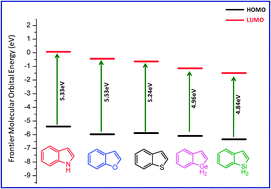Designing benzosiloles for better optoelectronic properties using DFT & TDDFT approaches†
Abstract
Like

- This article is part of the themed collection: Organic electronics - new physical chemistry insight
* Corresponding authors
a
Theoretical & Computational Chemistry Laboratory, School of Chemistry, Bharathidasan University, Tiruchirappalli – 24, Tamil Nadu, INDIA
E-mail:
venuvanalingam@yahoo.com
Fax: +91 431 2407045
Tel: +91 431 2407053
Like

 Please wait while we load your content...
Something went wrong. Try again?
Please wait while we load your content...
Something went wrong. Try again?
R. V. Solomon, A. P. Bella, S. A. Vedha and P. Venuvanalingam, Phys. Chem. Chem. Phys., 2012, 14, 14229 DOI: 10.1039/C2CP41554B
To request permission to reproduce material from this article, please go to the Copyright Clearance Center request page.
If you are an author contributing to an RSC publication, you do not need to request permission provided correct acknowledgement is given.
If you are the author of this article, you do not need to request permission to reproduce figures and diagrams provided correct acknowledgement is given. If you want to reproduce the whole article in a third-party publication (excluding your thesis/dissertation for which permission is not required) please go to the Copyright Clearance Center request page.
Read more about how to correctly acknowledge RSC content.
 Fetching data from CrossRef.
Fetching data from CrossRef.
This may take some time to load.
Loading related content
